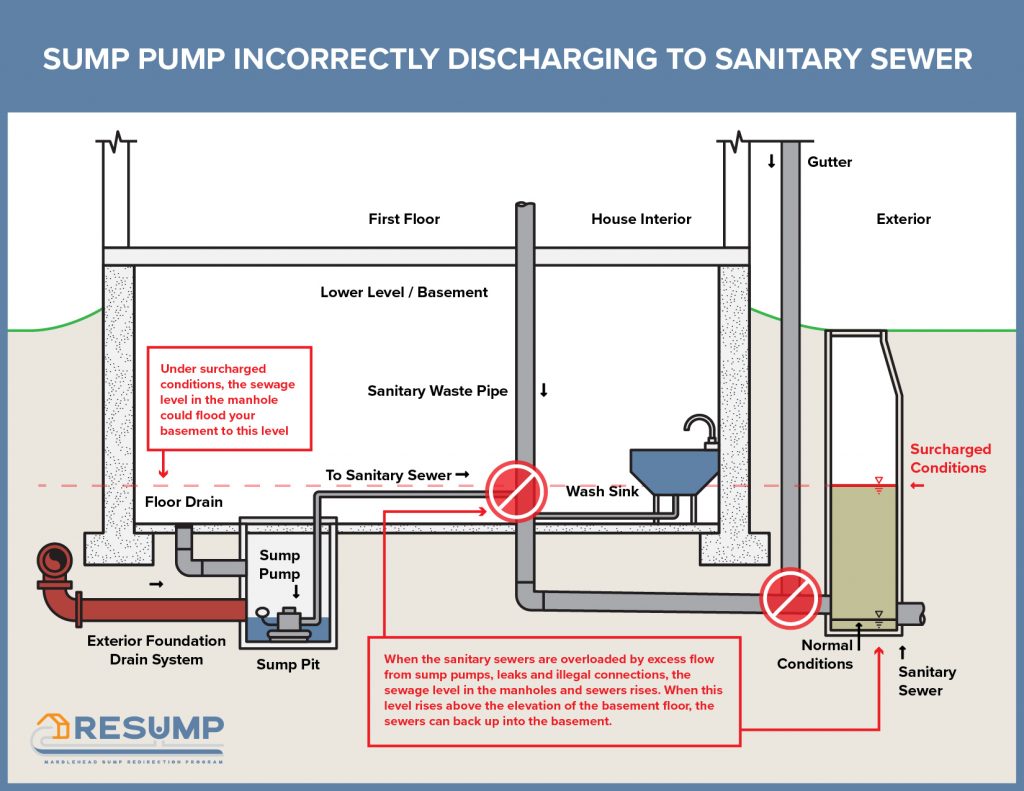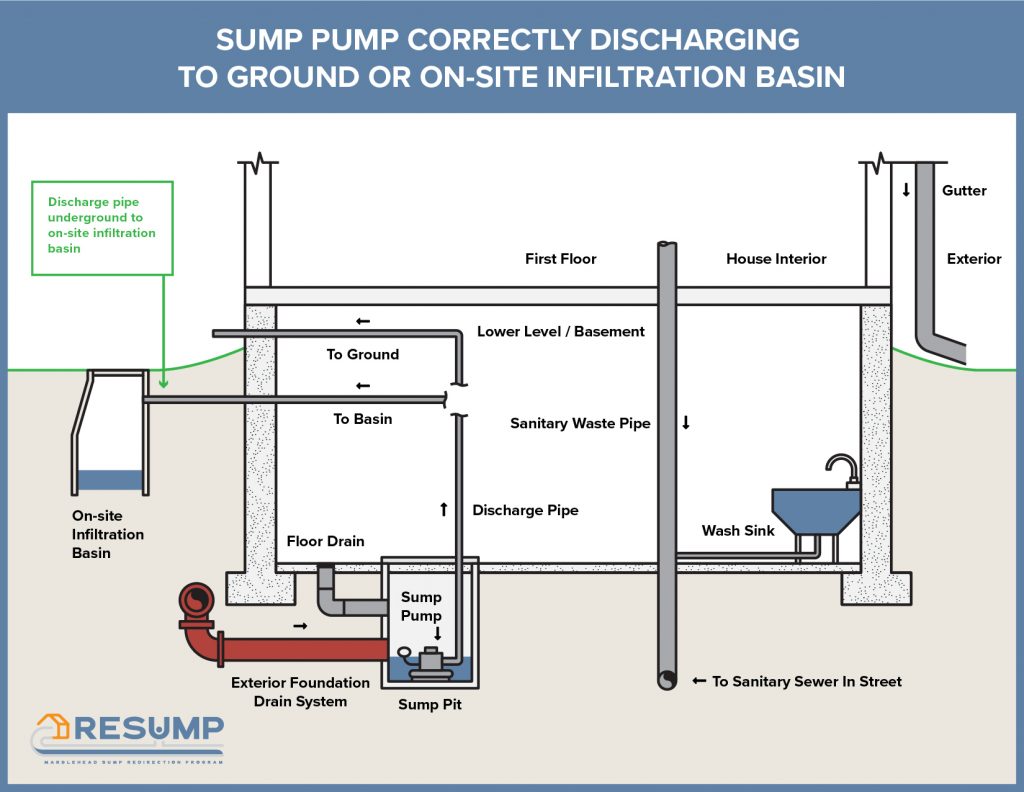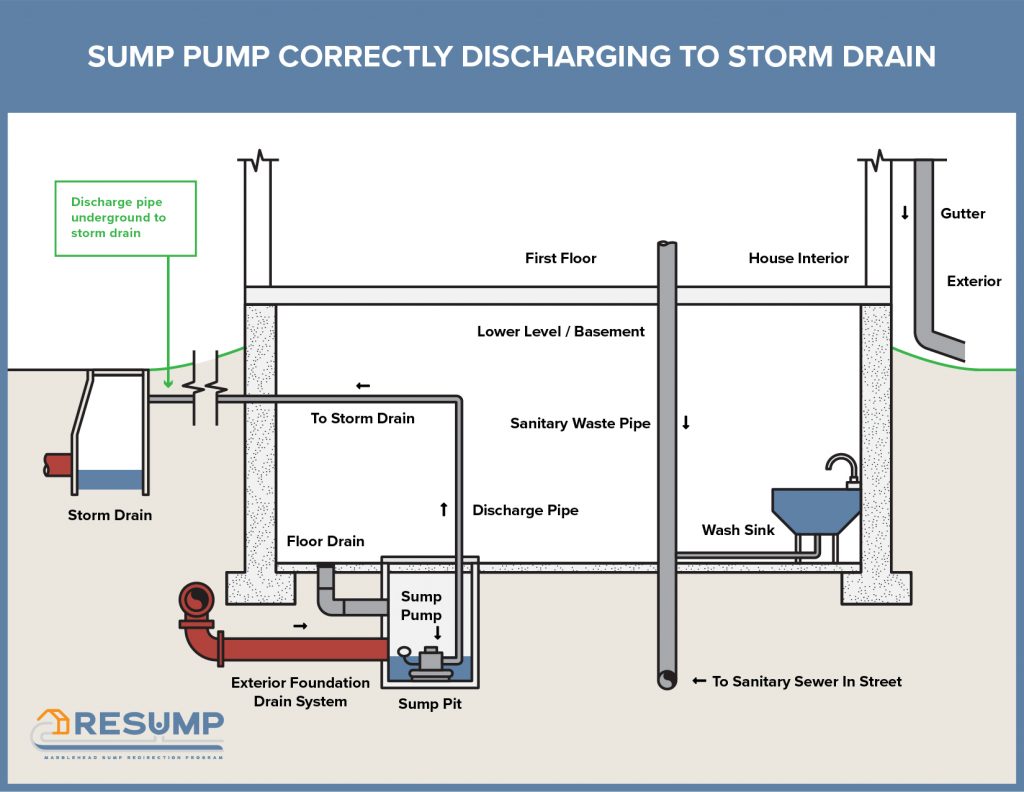RESUMP program overview
Your sewer system was designed to carry sanitary sewer from your home to the treatment plant. Sanitary sewage includes flow from toilets, showers, tubs, sinks, and washing machines in your home.
Excess flow comes from storms, snowmelt, and groundwater. Many homes have outdoor drains, roof drains, and sump pumps to direct rainwater, snowmelt, and groundwater away from the home. Often these drains and sump pumps are connected to the same sewer pipe that carries your sink, toilet, and washing machine water out to the public sewer.
During rainstorms, spring snowmelt, and high groundwater, the flow from these additional connections can flood the sewer system. When this causes backups and overflows, it can be easy to see why these connections should be removed.
But even when visible flooding and backups do not occur, this flow can still cause problems in the system and the treatment plant. Extra flow also increases sewer rates – treatment costs are by the gallon.
Marblehead sends 2 million gallons of Sewerage a day to the South Essex Sewerage District for treatment. This number increases dramatically after a rain event. Flows as high as 10 million Gallons a Day have been registered after heavy down pours or days of rain.

Why should I participate in RESUMP?
Marblehead sends wastewater flow to the South Essex Sewerage District (SESD) plant in Salem for sewage treatment. The Commission has to pay for every gallon of water it sends to the plant, including water from sump pumps illegally pumping into the sanitary sewer system. The water pumped by sump pumps into the system is often groundwater. Groundwater is clean water. It does not need any treatment before it is discharged to the outside environment.
A single residence can pump hundreds of gallons of water during a single storm. Multiply this by the number of illegal sump pump connections throughout the town, and it results in a very large, avoidable expense that is passed on to home owners through sewer rates. Removing sump pump flows from the sanitary sewer system will alleviate the strain on the wastewater treatment plant and neighborhood pump stations during heavy rain events, as well as reduce sewage backups and overflows throughout Marblehead. Extra flow means more maintenance and repair costs to the treatment plant and pump stations, another large expense passed on to rate payers.
Sewage backups and overflows can result in higher sewer bills, raw sewage backing up into your home or neighborhood, and reduced property values. Your own sump pump could cause a backup in your service line by flooding the line beyond its capacity. Sewer backups and overflows are also a public health risk and harm the environment, including beaches the ocean, open space and smalls water ways.
Having a sump pump connected to the sanitary sewer system is illegal, punishable by a fine, and each day in which a violation continues shall be considered a separate offense. The program provides an opportunity for property owners to correct this problem (without a fine).
The pipe from your basement sump pump should always discharge directly into your yard or storm sewer. While there are currently no regulations to require that sump pump discharges be connected to Marblehead’s storm drain system, doing so is strongly encouraged, if feasible.
In order to connect a sump pump discharge line to the storm drain system, the property owner must complete a “License Agreement for Private Connection to Town Drainage System” form available from the Department of Public Works. There is a $25.00 fee for this license.
Property owners who choose not to connect to the drain system have the responsibility to assure that water is discharged in such a manner so as not to cause any hazard or potential hazard on any public way. This includes, but is not limited to, the formation of ice from the discharge. In other words, you can’t discharge the water onto streets or sidewalks when there is a possibility of it freezing. Violations are liable to a penalty of $50.00 for each offence.
What should I look for?
The diagram (below) shows how a sump pump could be illegally connected to the sanitary sewer system. If you see that your sump pump discharge pipe is connected to the same pipe as a shower, sink, or toilet, you have an illegally connected sump pump.
The next two diagrams show how to correctly route your sump pump discharge towards the ground, on-site infiltration basin, or Town drainage system. This allows clean water from your sump pump to leave your home without costing additional (increases sewer rates) rate payer money, or overloading the Town sewer system.
Definitions
Infiltration – groundwater that enters the sanitary sewer system from the ground through broken pipes, pipe connections, and manholes.
Inflow – storm water that enters the sanitary sewer system via direct piped connections from roof and yard drains, sump pumps, or leaky manhole covers.
Sanitary sewer system – a system of pipes that collects raw sewage and wastewater from residences and businesses, then transports the flow to a wastewater treatment plant.
Storm drain system – a system of pipes that collect rainwater and runoff from streets, sidewalks, and other outdoor areas, then discharges the flow to a river, stream, or the ocean.
Sump pump – a mechanical device that pumps accumulated water from building foundation drains out and away from the property. It is in a sump pit in basement or crawl space areas.
Service line – the pipe that connects a building to the public sanitary sewer system. In Marblehead, the property owner owns their service line from their building all the way to the public sanitary sewer main.



